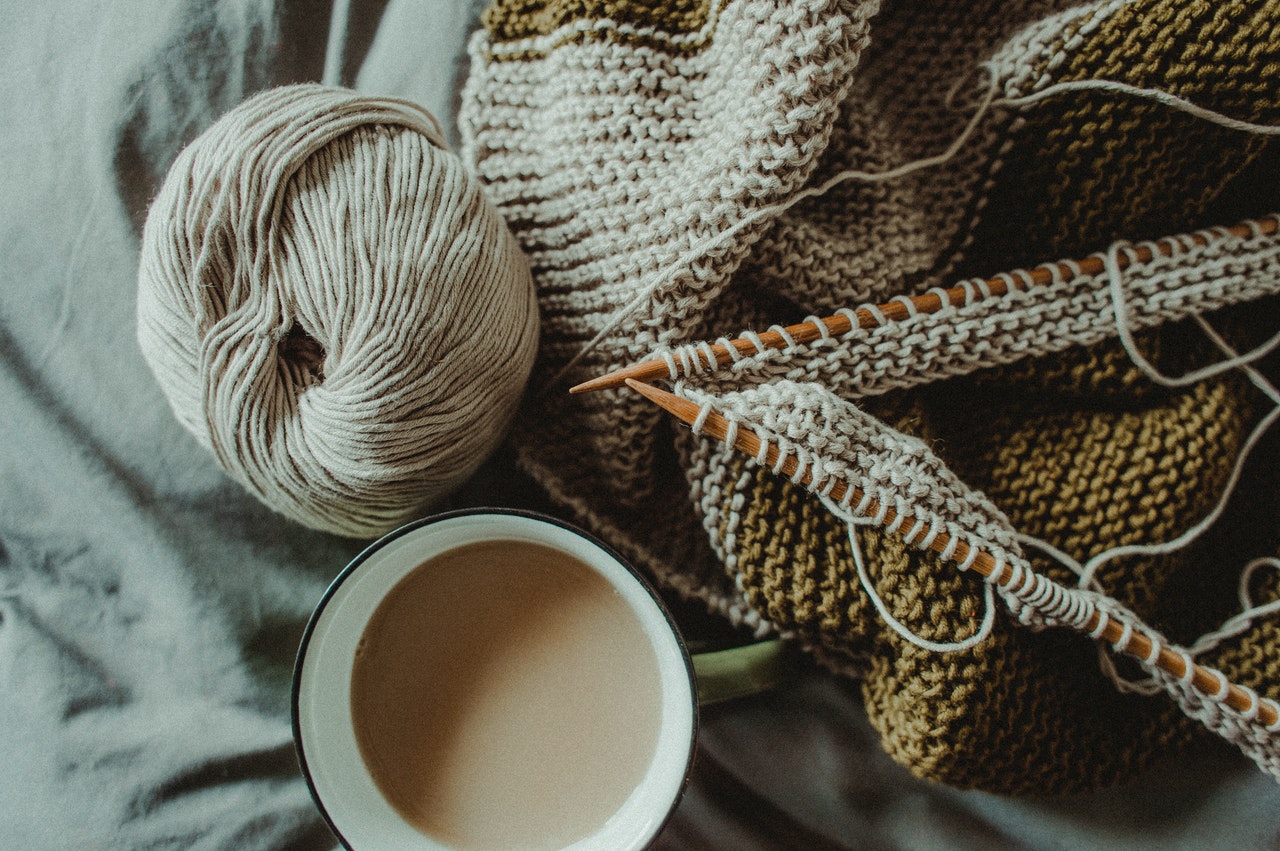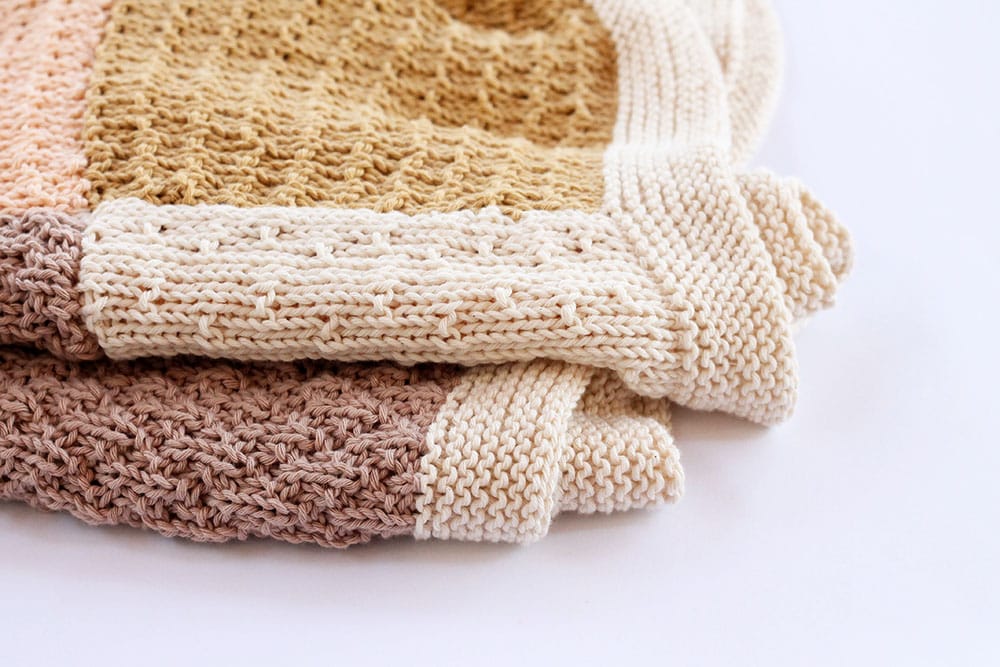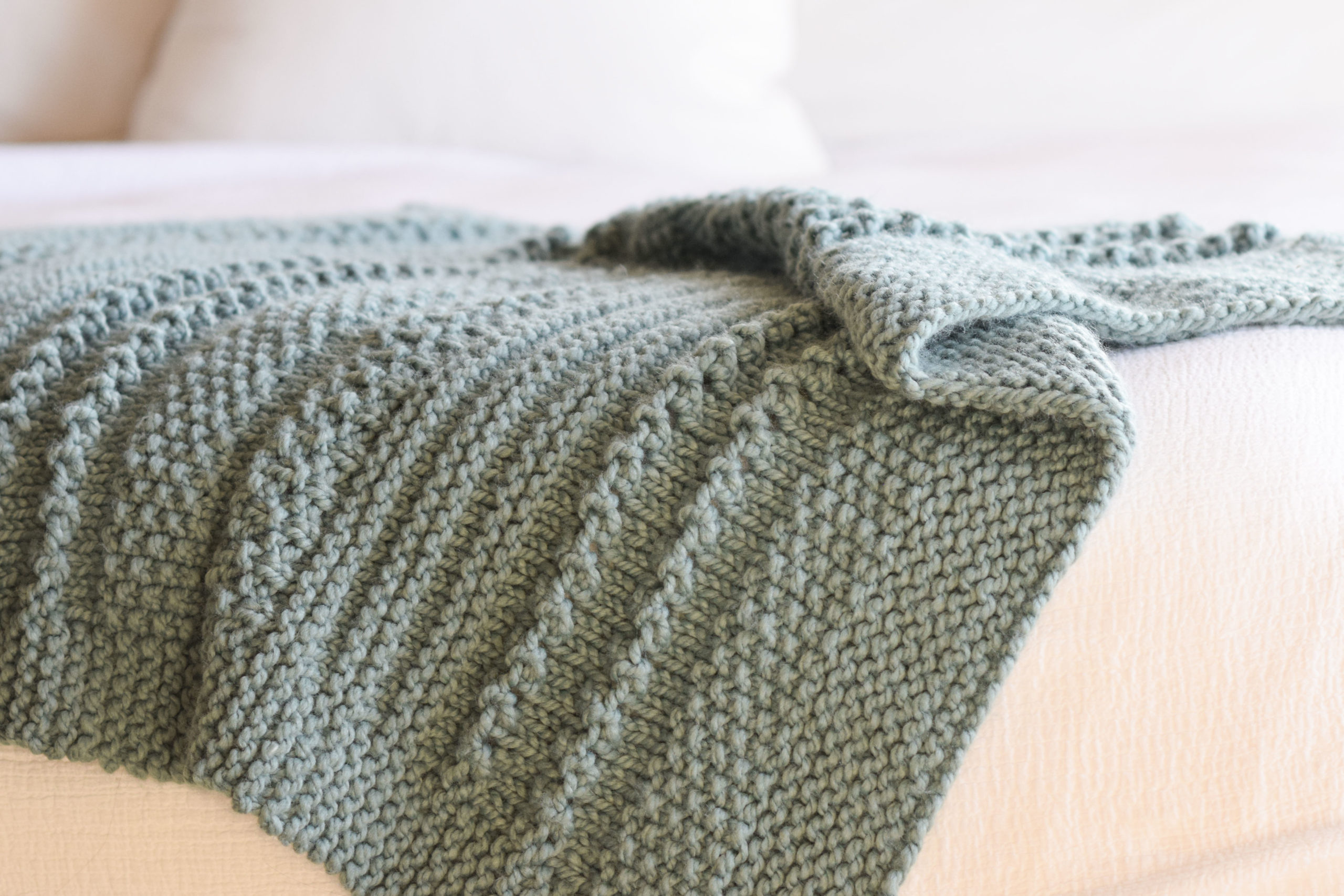Learning how to knit a blanket isn’t usually the first project you tackle as a knitting beginner. You’ll often start with a small project like a scarf. Or perhaps you’ll try finger knitting before you pick up those needles. But what if I told you that knitting your first blanket is easier than you might think?
If you’d like to know how to knit a blanket, look no further. A patch blanket would make a good starter project. Simply master the three basic knitting techniques: casting on, casting off, and knitting a basic stitch. Then begin by knitting square patches. Just stitch the patches together, and your very first blanket is done.
![how to knit a blanket]()
Many knitting projects can be long and tedious. Therefore, you must exercise patience to learn this skill. Once you know how to knit the basic stitches, you can knit anything from socks to beanies.
Knitting a blanket is a big undertaking and requires a few days of work. But the result is immensely satisfying. If you’re a beginner looking for a simple guide on how to knit a blanket, you’re in luck.
Here, we will discuss a few easy knitting stitches to help you learn how to knit a blanket.
Find a tutor for this topic
Knitting a Solid-Coloured Blanket
![Knitting a Solid-Coloured Blanket]()
For knitting, in a solid-coloured blanket, all you need is a few balls of yarn and two long knitting needles. I recommend chunkier yarns for beginners and US 10 sized needles.
Let’s begin with an easy 4ft wide blanket for children or to serve as a throw on your sofa. The following steps will guide you through how to knit a blanket with single-coloured yarn:
- To start knitting your solid-coloured blanket, make a slip knot, and pull it over the tip of your left-hand needle. Now, cast on 210 stitches to your left-hand needle.
- Once you have cast on and stitched the first row of your blanket, it’s time to use your right needle. Bring your right-hand needle through the last stitch cast on your previous row. Wrap the yarn clockwise around your right-hand needle.
- Now slightly pull your right needle backwards. Sliding the needle up through the loop of yarn, slowly pull the loop onto your right needle.
- Now that you’ve got your first stitch done you must repeat this basic stitch, described in step 3 above, across the entire second row of your blanket.
- Once you’ve finished the second row, slip the empty needle into the loop of the last stitch. Now repeat the basic stitch to start knitting your third row.
- Repeat steps 2 through 5 for the length of your blanket. You can make the blanket the size you prefer.
- When you are done and happy with the length of your blanket, you need to cast off your stitches. For this, take the empty needle in your right hand, and slide it through the last stitch you made.
- Knit two more basic stitches. Now use your left-hand needle to slide the first loop up and over the second stitch. You should have one stitch left on your right-hand needle.
- Now knit another basic stitch. Again, using your left-hand needle, slide the first loop up and over the second stitch. Repeat this process until there are no stitches left on your left-hand needle.
- You have now bound off your blanket. To make sure your blanket does not unravel, cut the working end of the yarn from the ball, leaving a few inches of loose thread.
- Take this loose end and pull it through the last hanging loop on your blanket to make a knot. Cut the excess thread, and your solid-coloured blanket is ready to use.
Knitting a Patch Blanket
![Knitting a Patch Blanket]() For knitting a patch blanket, you need to create knitted squares and patch them together. It’s a less complicated technique and generally quicker than knitting a solid-colored blanket.
For knitting a patch blanket, you need to create knitted squares and patch them together. It’s a less complicated technique and generally quicker than knitting a solid-colored blanket.
Suppose you’d like to knit a 4ft by 6ft blanket. For this, you’ll need to knit 54 8-inch squares and then patch them together.
If you are using a bulkier yarn, you should knit the squares using US 19 sized needles.
Without further ado, here is how to knit a blanket with square patches:
- Make a simple slipknot and slide it over your left-hand needle. Now, cast the stitches onto your needle using the long-tail technique. Do this until you complete the first side of your 8-inch square patch.
- Take the empty needle in your right hand and slide in through the last stitch on your left-hand needle. Then wrap the yarn on the top of the right-hand needle clockwise.
- Pull the right-hand needle backward. Lifting the tip of your needle as you slide the needle out, keeping the yarn wrapped tightly around it. This is the basic stitch you need to learn to know how to knit a blanket.
- Now slide your needle through the next loop on your left-hand needle and create another stitch, as above.
- Keep repeating this process for the entire row. Then you will have knitted the second row of your square patch.
- Repeat steps 2 to 5 above to knit the third row. Keep repeating this process until you have knitted an even square.
- Once you have completed your square patch, you need to cast the knitting off your needle. For this, knit two basic stitches. Now use your left-hand needle to slide the first loop up and over the second stitch. You should have one stitch left on your right-hand needle.
- Now knit another basic stitch. Again, using your left-hand needle, slide the first loop up and over the second stitch. Repeat this step until there are no stitches left on your left needle. Once done, you’ll have bound off your square.
- You need to knit 53 more squares of 8x8 inches each, to patch them up into a blanket.
- Once you are ready with your squares, arrange them on a flat surface in a blanket pattern.
- Position two squares next to each other and line up their edges. Now take your tapestry needle with an attached yarn and stitch it through the edge of the first square.
- Bring your needle through the yarn and poke it through the edge of the second square, sewing them tightly together.
- You need to repeat this process for all the squares, slowly stitching them together to make a patch blanket
Perhaps you’d like to learn the basic knitting techniques and how to knit a blanket from an expert. If so, head on over to Lrnkey and learn from the best.
Conclusion
Discovering how to knit a blanket doesn’t have to be a complicated process. In fact, with a bit of practice, you could be creating your first patch or solid-color blanket sooner than you think.
If you are new to knitting and are learning how to knit a blanket, you should try knitting smaller sections first. Consider a patch blanket as your first project. And then move on to knitting a solid-color blanket when you’ve had some practice.
And, if you follow our step-by-step guide above, you’ll be receiving blanket orders from friends and family in no time.
Anahit Babkenyan
Anahit Babkenyan is a Content writer at Lrnkey.com. Writing enthusiast and travel writer. She is a life-long learner and writes articles with profound research.


 For knitting a patch blanket, you need to create knitted squares and patch them together. It’s a less complicated technique and generally quicker than knitting a solid-colored blanket.
For knitting a patch blanket, you need to create knitted squares and patch them together. It’s a less complicated technique and generally quicker than knitting a solid-colored blanket.